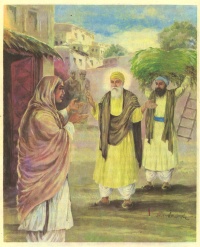Template:AOW324: Difference between revisions
Hari singh (talk | contribs) (Created page with '{{aowh|Mata Sulakhni}} {{p2|File:Mata Sulakhni, Guru Nanak and Bhai Lehna.jpg|Mata Sulakhni, Guru Nanak and Bhai Lehna}} '''Mata Sulakhni''' (1473-1545) was …') |
Hari singh (talk | contribs) No edit summary |
||
| Line 8: | Line 8: | ||
Two sons were born to the couple - [[Sri Chand]] in 1494 and [[Lakhmi Das]] in 1497. She survived Guru Nanak and is believed to have passed away in 1545 at [[Kartarpur]], an habitation that the Guru had founded on the right bank of the [[river Ravi]] and where she had spent the last years of her life. | Two sons were born to the couple - [[Sri Chand]] in 1494 and [[Lakhmi Das]] in 1497. She survived Guru Nanak and is believed to have passed away in 1545 at [[Kartarpur]], an habitation that the Guru had founded on the right bank of the [[river Ravi]] and where she had spent the last years of her life. | ||
In the book, [[Mahan Kosh]], Bhai Kahn Singh Nabha writes that a girl was born in the village Pakhoke, district Gurdaspur with "super characteristics," but neglects to elaborate what these were. He state that she was named ''Sulakhani''. | In the book, [[Mahan Kosh]], Bhai Kahn Singh Nabha writes that a girl was born in the village Pakhoke, district Gurdaspur with "super characteristics," but neglects to elaborate what these were. He state that she was named ''Sulakhani''. <!---- | ||
In 1969 Sikhs celebrated the 500th birth anniversary of their founder. Much research was done at that time and some literature was produced. Professor Sahib Singh has written that: "[[Bhai Jai Ram]] was resident of Khanpur and was in the service of [[Nawab Daulat Khan]]. | In 1969 Sikhs celebrated the 500th birth anniversary of their founder. Much research was done at that time and some literature was produced. Professor Sahib Singh has written that: "[[Bhai Jai Ram]] was resident of Khanpur and was in the service of [[Nawab Daulat Khan]]. | ||
For his official work, he used to go to Pakhoke village. There he talked to [[Baba Mool Chand]] for the marriage of his daughter, and he readily agreed to it. Guru Nanak was engaged on Visak 5, 1542, vs, and the marriage took place on Harh 24, 1544 (1487 AD) vs. Guru Nanak was 18 years old at the time of marriage." Sulakhani must have been about 14. ----->{{aowf|Mata Sulakhni}} | For his official work, he used to go to Pakhoke village. There he talked to [[Baba Mool Chand]] for the marriage of his daughter, and he readily agreed to it. Guru Nanak was engaged on Visak 5, 1542, vs, and the marriage took place on Harh 24, 1544 (1487 AD) vs. Guru Nanak was 18 years old at the time of marriage." Sulakhani must have been about 14. ----->{{aowf|Mata Sulakhni}} | ||
Revision as of 20:15, 23 September 2009
Mata Sulakhni (1473-1545) was the wife of Guru Nanak the founder of Sikhism. She was the daughter of Mool Chand (sometimes referred as Mul Chand Chauna), a Chona Khatri of Batala, who held a minor revenue office at the village of Pakkhoke Randhave in Gurdaspur district of the Punjab. Her mother's name was Chando Rani.
Sulakhani was married to Guru Nanak at Batala on 8 July 1487 (Harh 24, 1544) but this auspicious day is traditionally celebrated in Batala during late August each year.
Two sons were born to the couple - Sri Chand in 1494 and Lakhmi Das in 1497. She survived Guru Nanak and is believed to have passed away in 1545 at Kartarpur, an habitation that the Guru had founded on the right bank of the river Ravi and where she had spent the last years of her life.
In the book, Mahan Kosh, Bhai Kahn Singh Nabha writes that a girl was born in the village Pakhoke, district Gurdaspur with "super characteristics," but neglects to elaborate what these were. He state that she was named Sulakhani. .....More

